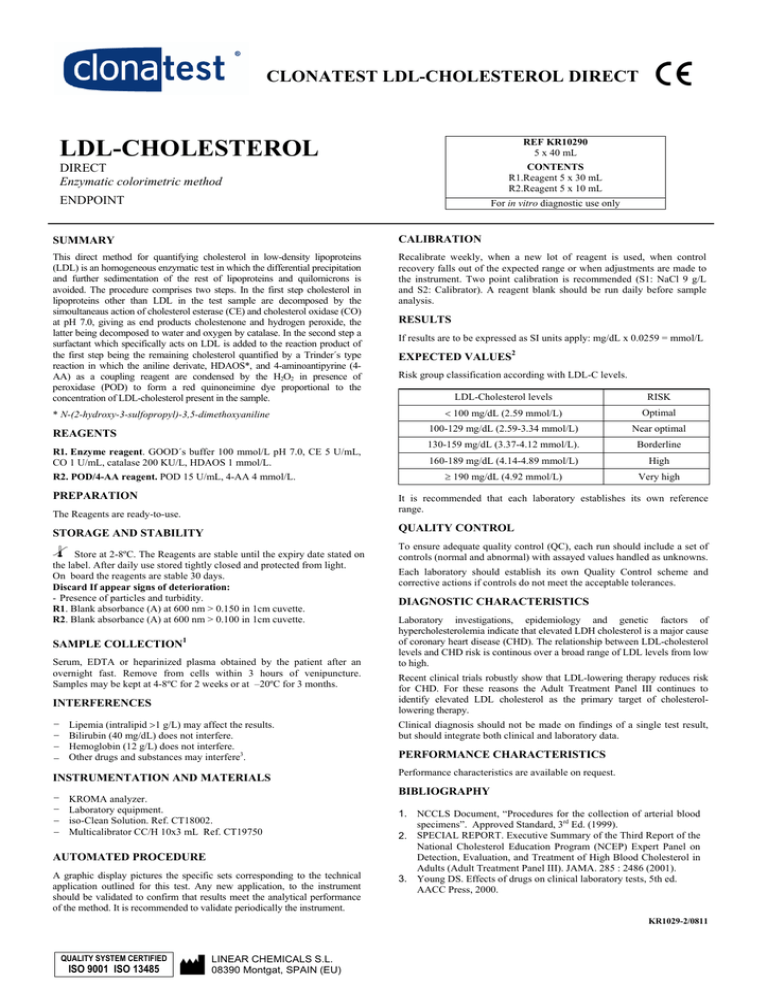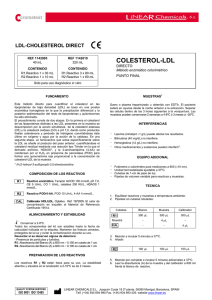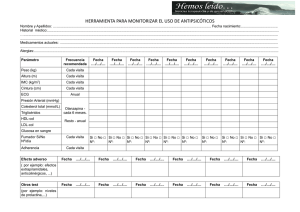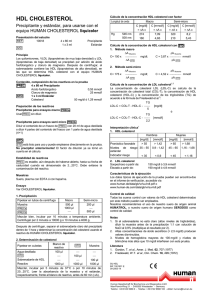ldl-cholesterol - LINEAR CHEMICALS
Anuncio

CLONATEST LDL-CHOLESTEROL DIRECT REF KR10290 5 x 40 mL LDL-CHOLESTEROL DIRECT Enzymatic colorimetric method CONTENTS R1.Reagent 5 x 30 mL R2.Reagent 5 x 10 mL ENDPOINT For in vitro diagnostic use only SUMMARY CALIBRATION This direct method for quantifying cholesterol in low-density lipoproteins (LDL) is an homogeneous enzymatic test in which the differential precipitation and further sedimentation of the rest of lipoproteins and quilomicrons is avoided. The procedure comprises two steps. In the first step cholesterol in lipoproteins other than LDL in the test sample are decomposed by the simoultaneaus action of cholesterol esterase (CE) and cholesterol oxidase (CO) at pH 7.0, giving as end products cholestenone and hydrogen peroxide, the latter being decomposed to water and oxygen by catalase. In the second step a surfactant which specifically acts on LDL is added to the reaction product of the first step being the remaining cholesterol quantified by a Trinder´s type reaction in which the aniline derivate, HDAOS*, and 4-aminoantipyrine (4AA) as a coupling reagent are condensed by the H2O2 in presence of peroxidase (POD) to form a red quinoneimine dye proportional to the concentration of LDL-cholesterol present in the sample. Recalibrate weekly, when a new lot of reagent is used, when control recovery falls out of the expected range or when adjustments are made to the instrument. Two point calibration is recommended (S1: NaCl 9 g/L and S2: Calibrator). A reagent blank should be run daily before sample analysis. * N-(2-hydroxy-3-sulfopropyl)-3,5-dimethoxyaniline REAGENTS R1. Enzyme reagent. GOOD´s buffer 100 mmol/L pH 7.0, CE 5 U/mL, CO 1 U/mL, catalase 200 KU/L, HDAOS 1 mmol/L. R2. POD/4-AA reagent. POD 15 U/mL, 4-AA 4 mmol/L. PREPARATION EXPECTED VALUES2 Risk group classification according with LDL-C levels. LDL-Cholesterol levels RISK < 100 mg/dL (2.59 mmol/L) Optimal 100-129 mg/dL (2.59-3.34 mmol/L) Near optimal 130-159 mg/dL (3.37-4.12 mmol/L). Borderline 160-189 mg/dL (4.14-4.89 mmol/L) High ≥ 190 mg/dL (4.92 mmol/L) Very high QUALITY CONTROL STORAGE AND STABILITY Store at 2-8ºC. The Reagents are stable until the expiry date stated on the label. After daily use stored tightly closed and protected from light. On board the reagents are stable 30 days. Discard If appear signs of deterioration: - Presence of particles and turbidity. R1. Blank absorbance (A) at 600 nm > 0.150 in 1cm cuvette. R2. Blank absorbance (A) at 600 nm > 0.100 in 1cm cuvette. SAMPLE COLLECTION1 Serum, EDTA or heparinized plasma obtained by the patient after an overnight fast. Remove from cells within 3 hours of venipuncture. Samples may be kept at 4-8ºC for 2 weeks or at –20ºC for 3 months. INTERFERENCES Lipemia (intralipid >1 g/L) may affect the results. Bilirubin (40 mg/dL) does not interfere. Hemoglobin (12 g/L) does not interfere. Other drugs and substances may interfere3. INSTRUMENTATION AND MATERIALS − − − − If results are to be expressed as SI units apply: mg/dL x 0.0259 = mmol/L It is recommended that each laboratory establishes its own reference range. The Reagents are ready-to-use. − − − − RESULTS KROMA analyzer. Laboratory equipment. iso-Clean Solution. Ref. CT18002. Multicalibrator CC/H 10x3 mL Ref. CT19750 AUTOMATED PROCEDURE A graphic display pictures the specific sets corresponding to the technical application outlined for this test. Any new application, to the instrument should be validated to confirm that results meet the analytical performance of the method. It is recommended to validate periodically the instrument. To ensure adequate quality control (QC), each run should include a set of controls (normal and abnormal) with assayed values handled as unknowns. Each laboratory should establish its own Quality Control scheme and corrective actions if controls do not meet the acceptable tolerances. DIAGNOSTIC CHARACTERISTICS Laboratory investigations, epidemiology and genetic factors of hypercholesterolemia indicate that elevated LDH cholesterol is a major cause of coronary heart disease (CHD). The relationship between LDL-cholesterol levels and CHD risk is continous over a broad range of LDL levels from low to high. Recent clinical trials robustly show that LDL-lowering therapy reduces risk for CHD. For these reasons the Adult Treatment Panel III continues to identify elevated LDL cholesterol as the primary target of cholesterollowering therapy. Clinical diagnosis should not be made on findings of a single test result, but should integrate both clinical and laboratory data. PERFORMANCE CHARACTERISTICS Performance characteristics are available on request. BIBLIOGRAPHY 1. NCCLS Document, “Procedures for the collection of arterial blood specimens”. Approved Standard, 3rd Ed. (1999). 2. SPECIAL REPORT. Executive Summary of the Third Report of the National Cholesterol Education Program (NCEP) Expert Panel on Detection, Evaluation, and Treatment of High Blood Cholesterol in Adults (Adult Treatment Panel III). JAMA. 285 : 2486 (2001). 3. Young DS. Effects of drugs on clinical laboratory tests, 5th ed. AACC Press, 2000. KR1029-2/0811 QUALITY SYSTEM CERTIFIED ISO 9001 ISO 13485 LINEAR CHEMICALS S.L. 08390 Montgat, SPAIN (EU) CLONATEST LDL-CHOLESTEROL DIRECT REF KR10290 5 x 40 mL COLESTEROL-LDL CONTENIDO R1.Reactivo 5 x 30 mL R2.Reactivo 5 x 10 mL DIRECTO Método enzimático colorimétrico Sólo para uso diagnóstico in vitro PUNTO FINAL FUNDAMENTO CALIBRACION Este método directo para cuantificar el colesterol en las lipoproteinas de baja densidad (LDL) se basa en una prueba enzimática homogénea en la que la precipitación diferencial y la posterior sedimentación del resto de lipoproteinas y quilomicrones ha sido eliminada. El procedimiento consta de dos etapas. En la primera el colesterol de las lipoproteinas distintas a las LDL presentes en la muestra se descomponen por la acción simultánea de la colesterol esterasa (CE) y la colesterol oxidasa (CO) a pH 7,0, dando como productos finales colestenona y peróxido de hidrógeno convirtiéndose éste último en oxígeno y agua por la acción de la catalasa. En una segunda etapa, un tensioactivo que actúa específicamente sobre la LDL se añade al producto del paso anterior, cuantificándose el colesterol residual mediante una reacción tipo Trinder en la que el derivado anilínico, HDAOS*, y la 4-aminoantipirina (4-AA) se condensan por el H2O2 en presencia de peroxidasa (POD) para formar una quinonaimina roja proporcional a la concentración de colesterol-LDL de la muestra. Recalibrar semanalmente, al cambiar el lote de reactivos, cuando los valores del control estén fuera del rango de aceptación o cuando se realicen ajustes en el instrumento. Se recomienda la Calibración de dos puntos (M1: ClNa 9 g/L y M2: Calibrador). Realizar un blanco del reactivo cada día de trabajo antes de analizar las muestras. CALCULOS Para expresar los resultados en unidades SI: mg/dL x 0,0259 = mmol/L VALORES DE REFERENCIA2 Grupos de riesgo clasificados según los niveles de LDL-C. Niveles de Colesterol-LDL RIESGO < 100 mg/dL (2,59 mmol/L) Muy Bajo * N-(2-hidroxi-3-sulfopropil)-3,5-dimetoxianilina 100-129 mg/dL (2,59-3,34 mmol/L) Bajo REACTIVOS 130-159 mg/dL (3,37-4,12 mmol/L) Moderado R1. Reactivo enzimático. Tampón GOOD 100 mmol/L pH 7,0, CE 5 U/mL, CO 1 U/mL, catalasa 200 KU/L, HDAOS 1 mmol/L. R2. Reactivo POD/4-AA. POD 15 U/mL, 4-AA 4 mmol/L. PREPARACION Alto ≥ 190 mg/dL (4,92 mmol/L) Muy alto Se recomienda que cada laboratorio establezca su propio rango de referencia. CONTROL DE CALIDAD The Reagents are ready-to-use. ALMACENAMIENTO Y ESTABILIDAD Conservar a 2-8ºC. Los Reactivos son estables hasta la fecha de caducidad indicada en la etiqueta. Después de su uso diario, mantener bien cerrado y protegido de la luz. En el analizador son estables 30 días. Descartar si se observan signos de deterioro: - Presencia de partículas y turbidez. R1. Absorbancia del Blanco (A) a 600 nm > 0,150 en cubeta de 1 cm. R2. Absorbancia del Blanco (A) a 600 nm > 0,100 en cubeta de 1 cm MUESTRAS1 Suero o plasma heparinizado u obtenido con EDTA. El paciente estará en ayunas desde la noche anterior a la extracción. Separar las células dentro de las 3 horas siguientes a la venipuntura. Las muestras pueden conservarse 2 semanas a 4-8ºC ó 3 meses a –20ºC. INTERFERENCIAS − − − − 160-189 mg/dL (4,14-4,89 mmol/L) Lipemia (intralipid >1 g/L) puede afectar los resultados. Bilirrubina (40 mg/dL) no interfiere. Hemoglobina (12 g/L) no interfiere. Otros medicamentos y sustancias pueden interferir3. Para un control de calidad (CC) adecuado, se incluirán en cada serie controles valorados (normal y abnormal) que se tratarán como muestras problema. Cada laboratorio debe establecer su propio Control de Calidad y sus medidas correctoras cuando los controles no cumplan con las tolerancias exigidas. SIGNIFICADO CLINICO Investigaciones de laboratorio, epidemiológicas y factores genéticos de la hipercolesterolemia indican que un colesterol-LDL elevado es una causa mayor de enfermedad cardíaca coronaria. La relación entre los niveles de colesterol-LDL y el riesgo de enfermedad coronaria es continuo en un amplio rango de concentraciones, aumentando el riesgo al incrementarse éstas. Pruebas clínicas recientes muestran con firmeza que la terapia dirigida a disminuir la tasa de colesterol-LDL reduce el riesgo de enfermedad cardíaca coronaria. Por estas razones el panel ATP III continúa en la identificación de tasas elevadas de colesterol-LDL como el objetivo principal de la terapia reductora de colesterol. El diagnóstico clínico no debe realizarse únicamente con los resultados de un único ensayo, sino que debe considerarse al mismo tiempo los datos clínicos del paciente. EQUIPO ADICIONAL CARACTERISTICAS ANALITICAS − − − − Las características analíticas están disponibles bajo solicitud. Analizador KROMA. Material de laboratorio. iso-Clean Solution. Ref. CT18002. Multicalibrator CC/H 10x3 mL Ref. CT19750 TECNICA AUTOMATICA Una representación grafica visualiza los ajustes específicos correspondientes a la aplicación técnica diseñada para este ensayo. Cualquier aplicación nueva al instrumento deberá validarse para confirmar que los resultados cumplen las características del método. Se recomienda validar periódicamente el instrumento. QUALITY SYSTEM CERTIFIED ISO 9001 ISO 13485 LINEAR CHEMICALS S.L. 08390 Montgat, SPAIN (EU) REFERENCIAS 1. NCCLS Document, “Procedures for the collection of arterial blood specimens”. Approved Standard, 3rd Ed. (1999). 2. SPECIAL REPORT. Executive Summary of the Third Report of the National Cholesterol Education Program (NCEP) Expert Panel on Detection, Evaluation, and Treatment of High Blood Cholesterol in Adults (Adult Treatment Panel III). JAMA. 285 : 2486 (2001). 3. Young DS. Effects of drugs on clinical laboratory tests, 5th ed. AACC Press, 2000. Aplicaciones en KROMA Applications on KROMA LDL-CHOLESTEROL DIRECT Two reagents method LDL-Cholesterol Direct (5 x 40 mL), Code KR10290 USO USE Reactivo de diagnóstico in vitro para la determinación de las lipoproteínas de baja densidad (LDL) en suero o plasma. In vitro diagnostic reagent for the determination of low density lipoproteins (LDL) in serum or plasma. METODO METHOD Enzimático colorimétrico. Enzymatic colorimetric. MUESTRA SAMPLE Suero o plasma heparinizado u obtenido con EDTA. Serum or EDTA or heparinized plasma. REACTIVOS REAGENTS Los reactivos R1 y R2 están listos para su uso. The reagents R1 and R2 are ready to use. CALIBRADOR STANDARD HDL/LDL Calibrator, Code CT19750 CONTROL CALIDAD QUALITY CONTROL Linear Human Multisera Normal CT19800 Linear Human Multisera Abnormal CT19850 DETERMINACIONES NUMBER OF TESTS 1000 tests/kit, Code KR10290 (no se considera el volumen muerto). (dead volume is not taken in consideration). LINEALIDAD LINEARITY Sin post-dilución automática: Hasta 1000 mg/dL Without automatic post-dilution: Up to 1000 mg/dL. NOTA NOTE Para más información lea el prospecto del reactivo For additional information read reagent packaging insert. NOTA DE AVISO WARNING La aplicación incluida se da solamente como pauta. Cualquier aplicación deberá ser validada con el fin de demostrar que se cumplen las características analíticas del método. The reported application is given only as a guideline. Any application to an instrument should be validated to demonstrate that results meet the performance characteristics of the method. QUALITY SYSTEM CERTIFIED ISO 9001 ISO 13485 LINEAR CHEMICALS S.L. 08390 Montgat, SPAIN (EU) KROMA Name LDL-Cholesterol Direct N. of Standards 2 LDL-CHOLESTEROL DIRECT N. of rep. 1 Units mg/dL * * QUALITY SYSTEM CERTIFIED ISO 9001 ISO 13485 entered by the user LINEAR CHEMICALS S.L. 08390 Montgat, SPAIN (EU) KR10290-1/0907 Stability


